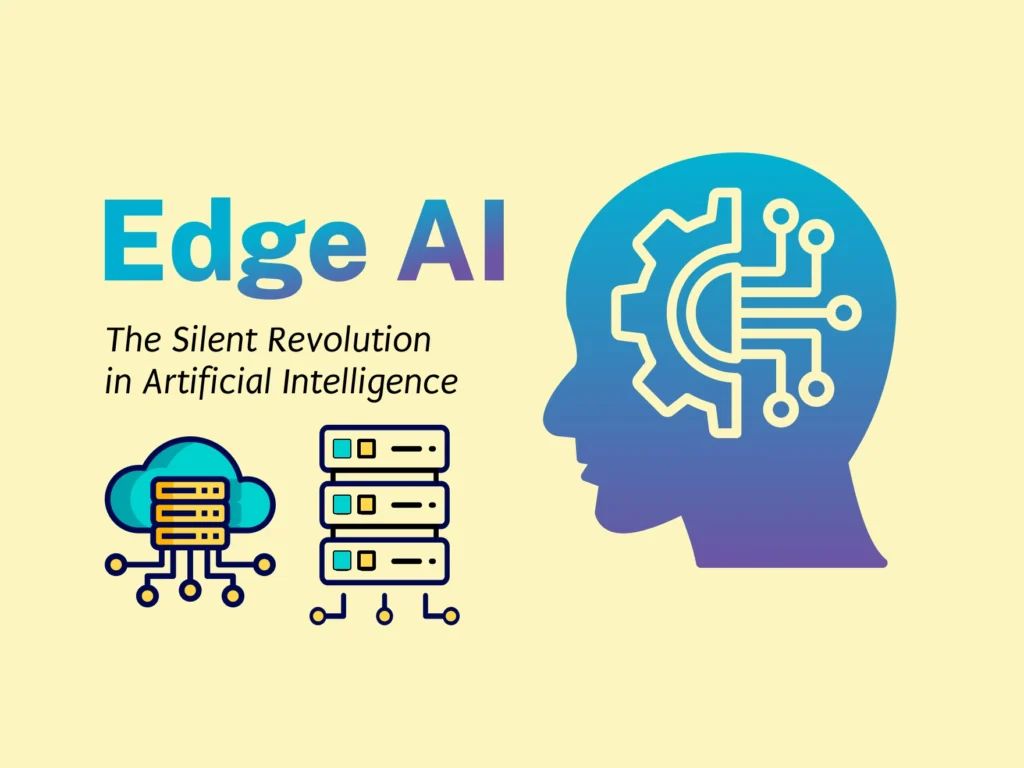In today’s world, artificial intelligence (AI) is grabbing headlines everywhere, transforming the way we work, communicate, shop, and even live. Whether it’s large language models like ChatGPT, image recognition tools in smartphones, or voice assistants like Alexa, AI seems to be everywhere. But beneath the surface of all this buzz lies a quiet, game-changing revolution that doesn’t always get the limelight – Edge AI.
Edge AI may not be as flashy as generative art or as viral as chatbots, but it is just as transformative, perhaps even more so for the way we integrate intelligence into the physical world. It combines the power of AI with the efficiency of edge computing, allowing data processing to happen closer to where it’s generated, rather than relying on distant cloud servers.
So what does this mean and why is it such a big deal?
What is Edge AI?
Edge AI refers to the deployment of artificial intelligence algorithms directly on edge devices: smartphones, cameras, drones, sensors, industrial robots, and more. These are the “edges” of the network, the places where data is generated, not centralized. Traditionally, AI models process data in the cloud, which requires sending information back and forth over the internet. That takes time and can pose security and privacy risks.
Edge AI flips the script. It processes data locally, enabling real-time decision-making, enhanced privacy, and more efficient use of bandwidth. For example, a self-driving car can’t afford to wait for a cloud server to decide whether to brake, milliseconds matter. That decision needs to happen on the spot. That’s the power of Edge AI.
Why Edge AI Matters: Real-World Applications

Edge AI isn’t a future concept, it’s already reshaping a wide range of industries:
1. Smart Manufacturing
In factories, Edge AI enables predictive maintenance by identifying faults in machines before they break down. It also ensures quality control through real-time inspection and helps optimize workflows minimizing downtime and maximizing productivity.
2. Autonomous Vehicles
Self-driving cars are perhaps the most vivid example of Edge AI in action. These vehicles use sensors and cameras to detect their surroundings. Edge AI processes this data locally for obstacle avoidance, speed control, and route planning without relying on a network connection.
3. Smart Cities
From traffic signals that adapt in real-time to environmental monitoring systems that track air quality, Edge AI is at the heart of urban innovation. By analyzing sensor data locally, cities can improve public safety, reduce congestion, and conserve resources.
4. Healthcare
Wearable health monitors use Edge AI to track vitals such as heart rate, blood pressure, and oxygen levels. They can alert doctors instantly if something seems off—potentially saving lives, especially in remote areas with limited connectivity.
5. Retail and Customer Experience
Smart cameras and sensors in stores can analyze customer behavior, track inventory, and even customize promotions in real time. Edge AI personalizes the shopping experience while keeping sensitive data on-device.
6. Agriculture
Farmers use Edge AI to monitor soil conditions, crop health, and weather patterns. By analyzing data in the field, they can optimize irrigation and fertilizer use, improving yield and sustainability.
7. Security and Surveillance
Surveillance systems powered by Edge AI can detect unusual behavior or identify known threats instantly, without needing to stream hours of footage to a server.
Edge AI in the Workplace: A Smarter Future
In today’s distributed work environments, Edge AI is also powering seamless collaboration. AI-enabled cameras and microphones in meeting rooms can adjust audio and video in real-time, optimize bandwidth, and ensure smooth virtual meetings—even in areas with patchy internet.
This means businesses no longer need to invest heavily in cloud infrastructure or worry about lag, latency, or privacy. Edge AI delivers intelligent features directly at the source, enabling more scalable, secure, and efficient operations.
How Edge Signal is Leading the Charge
One company helping to simplify the complexity of Edge AI is Edge Signal. Their platform provides ready-to-use infrastructure for deploying and managing AI at the edge. With a centralized dashboard, real-time monitoring tools, and remote access capabilities, Edge Signal makes it easier for businesses to roll out Edge AI solutions without needing a team of on-site technicians.
By abstracting away the technical hurdles, they allow developers, IT teams, and system integrators to focus on outcomes rather than engineering headaches. It’s a step toward democratizing AI—bringing smart capabilities to every corner of the digital and physical world.
The Way Forward
Edge AI may not grab the spotlight like other flashy tech trends, but its impact is quietly reshaping how we think about automation, intelligence, and data. As sensors and connected devices proliferate, the need for local processing will only grow.
This silent revolution is already here and it’s changing everything from how your phone understands your voice to how a drone monitors a farm or a car drives itself. Edge AI isn’t just another technological milestone. It’s a paradigm shift.
At FACE Prep Campus, our industry aligned degree program equips students and professionals with the skills and insights needed to thrive in a rapidly evolving technological landscape. As industries shift toward decentralized intelligence and real-time decision-making, understanding emerging trends like Edge AI becomes critical. FACE Prep Campus is your launchpad to stay informed, inspired, and industry-ready.
FAQs
1. What is the main advantage of Edge AI over traditional cloud-based AI?
A: Edge AI processes data locally, resulting in faster decision-making, improved data privacy, and reduced latency compared to cloud-based systems.
2. How does Edge AI help in data security?
A: Since data is processed directly on the device and doesn’t have to travel to cloud servers, there’s a reduced risk of interception or data breaches.
3. Is Edge AI the future of AI deployment?
A: Yes. With the rise of connected devices and real-time applications, Edge AI is becoming essential for efficient, responsive, and secure AI integration.
